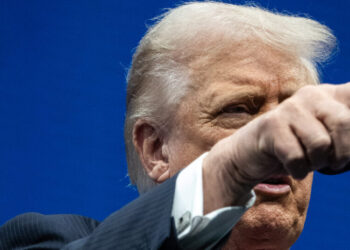On a weekday afternoon this fall, the largest museum in South Korea looked as if it were preparing for a K-pop concert. Outside, a maze of crowd control barriers had been installed. A sign at the gift shop warned of “high visitor traffic.” And no, another sign asserted, the shop no longer has the merch they know you came to buy. If buildings could talk, this museum would be asking you to chill.
This year, the National Museum of Korea has seen more than 5 million visitors, a record-breaking figure that places it near the Met and the British Museum. The influx has been attributed in part to the soaring popularity of “KPop Demon Hunters,” a movie about an evil-fighting girl group that is rich with references to Korean visual culture — including a dim-witted creature named Derpy who is based on a folk-art tiger. (Again, his souvenir pin is SOLD OUT.)
Now, the National Museum of Korea is sharing some of that love with D.C. as one of the primary lending institutions in the largest exhibition of Korean art in the Smithsonian National Museum of Asian Art’s history. The show, “Korean Treasures: Collected, Cherished, Shared,” opened Saturday (following a delayed start due to the government shutdown) and includes over 200 works and a dozen national treasures, making strides in museum representation for Korea, which has long been treated as a sidepiece to better-endowed collections of Japanese and Chinese art in Western museums.
Chase F. Robinson, the museum’s director, called it “the biggest thing that’s going to happen this decade in Korean art history in North America.”
The Museum of Asian Art expects the show to “not only be popular, but to skew quite young,” Robinson said, noting that the institution has boosted its Korean programming in recent years. “We’re as enthusiastic and fanboyish or fangirlish as anyone else is with Korean popular culture,” he said. “But also it’s important that we understand, our audience understands, the deep wellsprings of creativity in Korean culture.”
Korean culture has permeated nearly every aspect of life: K-pop’s ear worms have wiggled their way into our heads. K-dramas have flooded streaming services. K-food has sold out at grocery stores. K-beauty products crowd shelves at makeup stores. The phenomenon is often dubbed the “Korean wave.”
The NMAA exhibition both rides and cuts deeper than the trends, showing the visual world of a country that went from shunning outsiders (it was once referred to as the Hermit Kingdom) to accruing enviable soft power on the global stage. Here, Korean culture is no wave, it simply flows.
“You do walk around with a really strong sense not only of the extraordinary traditions of what I’ll call premodern Korean arts, but also a discernibly Korean trajectory of modernism,” said Robinson, describing the show as “capacious.”
Sunglim Kim, a professor of Korean art history at Dartmouth College, sees the rise of K-culture as part of a larger story. Chinoiserie popularized Chinese visual culture in 18th century Europe, and Edo-period woodblock prints spread Japanese aesthetics to the West, influencing impressionism and art nouveau. “It is not an isolated trend,” she said, “but the latest chapter in the centuries-long dialogue between East Asia and the world.”
For Kim, who years ago did her Ph.D. under a Chinese art professor because no one at her university taught Korean art, the Smithsonian exhibition marks a vital chapter. The show reflects “a decisive shift from viewing Korean art as a regional adjunct to China and Japan toward recognizing it as an autonomous and essential voice within world art history,” she said.
The exhibition draws from the collection of Lee Kun-hee, the late controversy-ensnared Samsung chairman, who was an avid art collector. During his life, Lee was convicted of bribery and tax evasion, and a Samsung warehouse holding art was even raided as part of an investigation; he was later pardoned in both cases. After Lee died in 2020, his family, facing the largest estate tax bill in South Korean history, gifted more than 23,000 works, amassed by Lee and his equally art-obsessed father, Samsung Founder Lee Byung-chul, to several Korean museums.
The collection has played an important role in constructing a continuous art-historical narrative in a country fragmented both by Japanese colonialism and the Korean War. Lee Byung-chul sought to “reestablish the Korean identity,” said Kim, while his son, Lee Kun-hee, worked to expand the collection, uniting the classical and the contemporary.
Some have criticized the gift for reflecting the Samsung family’s seemingly vast influence over South Korean society, as the country’s infamous chaebols (family-run conglomerates) are known to have. But it’s also driven crowds: In 2022, during the closing weekend of an exhibition of works from the collection in Seoul, the average wait for entry was four hours, ARTNews reported.
Sunwoo Hwang, NMAA’s inaugural curator of Korean art, described Lee’s taste as “wide and broad.” Works in the show stretch hundreds of years from Korea’s Three Kingdoms period, a roughly 700-year era that ended in the 7th century A.D., to the 20th century.
There are challenges to building a show around a collection. It can be uneven in quality, not comprehensive and risk feeling too much like a story about a collector.
So curators sought to find stories “you can relate to across time,” said Hwang, pointing to a piece of calligraphy describing the pain of losing his son. “So it’s not just about Korean art, but trying to understand the lives of Koreans.”
Then there are the parts that are just fun: A lion-shaped drum, rich with color and personality, is likely to remind knowing viewers of Derpy, Hwang said. She thinks it’ll be hit.
J. Keith Wilson, curator of Ancient Chinese Art at the museum, who worked on the show, said they chose to tell the story through themes, rather than, say, chronologically. “Sometimes, I’ve thought of our presentation as almost like a series of boutiques,” he said.
If these were boutiques, “chaekgado” paintings, which look like the curated bookshelves of the pandemic era, would surely find buyers among D.C.’s talking heads. Meanwhile, the clothing of Joseon-era portrait subjects, which boast traditional patterns similar those on the costumes the girl group wears in “Demon Hunters,” would sell out. The portrait’s faces, however, would likely serve as advertisements for a skin care shop: Rendered with a painful, pimply realism, these Joseon-era men look as if they’ve never even heard of a K-beauty ritual.
Wilson hopes the show will put the NMAA on the map for Korean art in a new way. The museum was early to exhibiting Korean works, with a substantive collection of celadon wares, but hasn’t expanded that collection much, a reality that is part of a wider picture of East Asian art in museums in the West.
“Often the Korean story was invisible or only incompletely told,” Wilson said.
That is slowly changing. NMAA said it will soon announce a number of Korean art acquisitions. Several institutions, including NMAA, have appointed their first curators of Korean art in recent years. Kim, the Dartmouth professor, recently contributed two chapters to Pearson’s new edition of “Art History,” a book that previously folded Korea in with Chinese art. Past covers routinely featured Western art, but this edition, published earlier this year, highlights the magpie and tiger motif that “Demon Hunters” would later skyrocket to viral fame.
To Dae Young Kim, a sociology professor at George Mason University who studies the reception of Korea popular culture in the United States, it makes sense that this particular movie has fueled an interest in Korean aesthetics.
“Korean music is very much a fusion and has very little Korean-ness, except that the songs are sung in Korean,” he said, but the film “seems to really bring out the Korean elements much more strongly.”
Toward the end of the movie, the girl group, in a singing battle, performs in front of a huge screen showing five jagged mountains against a royal blue sky, accented with a red sun and a white moon.
The image may, at first, scan as just a pretty background. But the same painting appears in a folding screen in the NMAA show. And in Korea, it plays on repeat at historic sites. During the Joseon era, that image, “irworobongdo,” was created solely for the king, “symbolizing his presence and authority,” according to the exhibition’s catalogue.
There’s no king nor K-pop star standing front of it in D.C., but it is displayed in an exhibition of long-underappreciated Korean art. Perhaps it does precisely the same thing.
The post In time for ‘KPop Demon Hunters’ mania, a major Korean art show lands in the U.S. appeared first on Washington Post.




